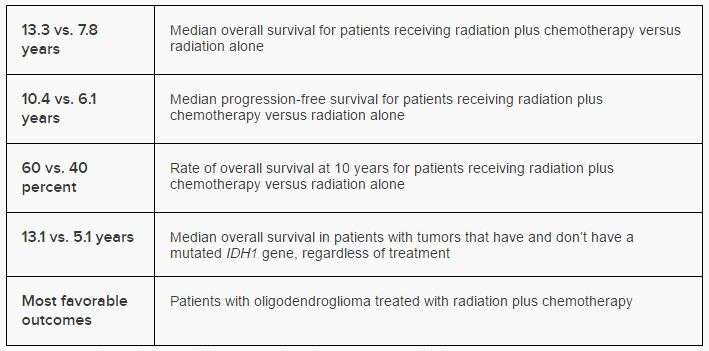Low-grade brain tumors: Radiation plus chemotherapy is best treatment, trial suggests
New clinical-trial findings show that patients with a low-grade form of brain cancer who are treated with radiation plus a combination of chemotherapy drugs have better survival than patients treated with radiation alone.
The study, published in the New England Journal of Medicine, comes from a randomized phase III clinical trial (ClinicalTrials.gov number NCT00003375) of 251 people with grade 2 gliomas, tumors that occur mostly in young adults and cause progressive neurological problems and premature death. Researchers at The Ohio State University Comprehensive Cancer Center - Arthur G. James Cancer Hospital and Richard J. Solove Research Institute (OSUCCC - James) helped lead the study.
Patients treated with radiation therapy plus chemotherapy had an overall survival of 13.3 years compared with 7.8 years for patients treated with radiation alone. The radiation-plus-chemotherapy group also showed better disease-free survival (10.4 years versus 6.1 years for those treated with radiation alone).
In addition, patients with tumor cells having a mutation in a gene called IDH1 had significantly better overall survival than those without the mutation, regardless of treatment (13.1 years versus 5.1 years).
"This is a practice-changing study," says Arnab Chakravarti, MD, chair and professor of Radiation Oncology and director of the Brain Tumor Program at the OSUCCC - James. Chakravarti is the trial's translational research national study chair.
"These findings show that this combined radiation and chemotherapy regimen improves clinical outcome compared to radiation alone.
Chakravarti's lab was instrumental in validating IDH1 as a prognostic biomarker during the trial. "Furthermore, trends in the data suggest that IDH1 could be a useful predictive biomarker to identify glioma patients who would benefit from chemotherapy plus radiation therapy versus radiation therapy alone. These are immensely impactful findings of this phase III study," he says.
(Predictive biomarkers help predict a patient's response to a particular therapy; prognostic biomarkers help predict survival regardless of the therapy used.)
"Many low-grade gliomas progress to much more lethal grade III and IV tumors over time, so identifying the most effective treatment strategy is critical to ensure that patients have the best outcomes," says Chakravarti, who is also the Max Morehouse Chair in Cancer Research at Ohio State.
Low-grade gliomas represent less than 1 percent of all human tumors in the United States. The average survival times vary depending on the tumor's structural, molecular and genetic features.
The trial, which was sponsored by the Radiation Therapy Oncology Group, enrolled patients from 1998 to 2002. Median follow-up time for surviving patients was 11.9 years. About half the patients were treated with radiation therapy plus three chemotherapy drugs: procarbazine, lomustine (also called CCNU) and vincristine.
The study's key findings:

More information: Jan C. Buckner et al. Radiation plus Procarbazine, CCNU, and Vincristine in Low-Grade Glioma, New England Journal of Medicine (2016). DOI: 10.1056/NEJMoa1500925















